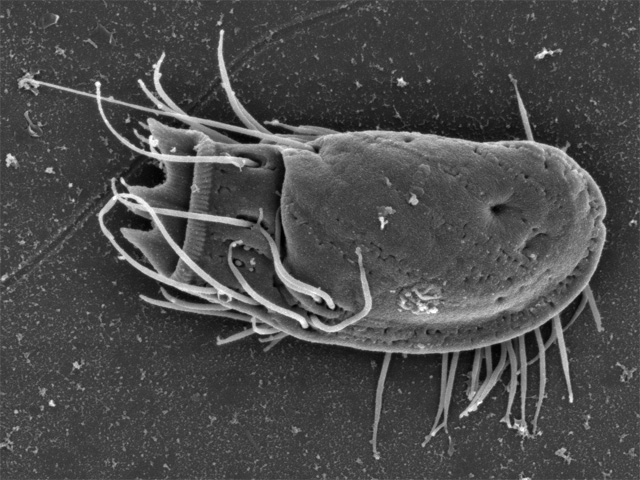- Stephanopogon
Taxobox
color = khaki
name = "Stephanopogon"

image_width = 220px
image_caption = "Stephanopogon" sp.
domain =Eukaryota
ordo = Pseudociliatida
ordo_authority = Corliss & Lipscomb 1982
genus = "Stephanopogon"
genus_authority = Entz 1884"Stephanopogon" is a peculiar marine
protozoa n. It closely resembles certainciliate s and was originally classified with them, but is now considered aflagellate . The cell is somewhat flattened, with multiple smooth flagella arranged in rows running from the front to the back, and has an anterior mouth supported by rods. They feed on bacteria,diatom s, and other smaller organisms. There are 2-16 nuclei, but they are not differentiated intomacronuclei andmicronuclei as occurs in ciliates.Because the nuclei are
homogeneous , "Stephanopogon" has been regarded as an evolutionary intermediate between the ciliates and other protozoa, and possibly an ancestor of the animals as well. However, Corliss and Lipscomb showed that it is not related tociliates , and lacks their complex pellicle and infraciliature [cite journal | author = Corliss, J.O. and Lipscomb, D.L.
title = Establishment of new order in kingdom Protista for "Stephanopogon", long-known "ciliate" revealed now as a flagellate
journal = Journal of Protozoology
year = 1982 | volume = 92 | pages = 294] . "Stephanopogon" has mitochondria with discoidcrista e and lacks dictyosomes, like thePercolozoa . These morphological comparisons are consistent with the molecular phylogenetic analyses by Yubuki and Leander (2008), which demonstrated that "Stephanopogon" is closely related to "Percolomonas" within the Heterolobosea.References
Yubuki, N. and Leander, B.S. 2008. Ultrastructure and molecular phylogeny of Stephanopogon minuta: an enigmatic microeukaryote from marine interstitial environments. Europ. J. Protistol. 44: In press.
External Links
* [http://tolweb.org/Stephanopogon/124646 Tree of Life: Stephanopogon]
Wikimedia Foundation. 2010.
